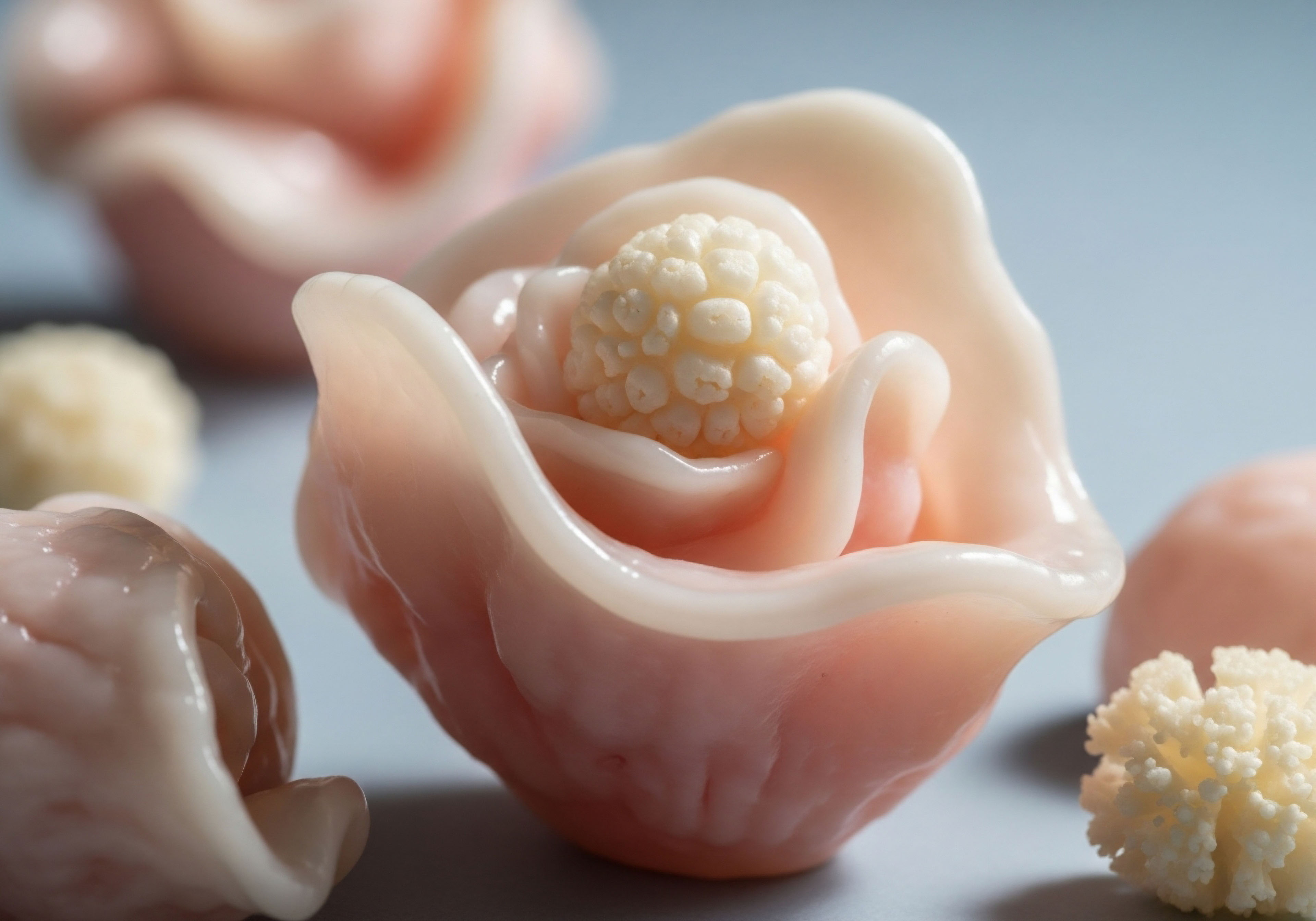

Fundamentals
For many individuals, the experience of hormonal fluctuations manifests as a disquieting array of symptoms ∞ shifts in mood, alterations in sleep patterns, or subtle yet persistent changes in physical vitality. These lived experiences often prompt a deeper inquiry into the body’s intricate internal messaging system.
Understanding how lifestyle factors like dietary choices or supplemental regimens influence the processing of progesterone offers a profound pathway toward reclaiming optimal function and a sense of internal balance. Progesterone, a steroid hormone synthesized primarily in the ovaries following ovulation, the adrenal glands, and during pregnancy, serves far more roles than its familiar association with reproduction. It acts as a foundational modulator across numerous physiological systems, influencing neurocognitive function, mood stability, and even the integrity of connective tissues.
Progesterone orchestrates a symphony of physiological processes beyond reproduction, impacting mood, sleep, and overall cellular well-being.
The journey of progesterone within the body, from its initial synthesis to its eventual elimination, represents a complex cascade of biochemical transformations. This journey begins with cholesterol, the precursor molecule for all steroid hormones. Enzymes within the steroidogenic pathway, particularly in the adrenal glands and gonads, convert cholesterol into pregnenolone, which then undergoes further enzymatic modification to become progesterone. This initial synthesis is only the beginning of progesterone’s dynamic existence.

The Hepatic Orchestration of Progesterone
Upon fulfilling its diverse biological functions, progesterone undergoes extensive metabolism, predominantly within the liver. Hepatic enzymes, members of the cytochrome P450 (CYP450) superfamily, play a central role in transforming progesterone into various metabolites. This biotransformation is a crucial step in preparing the hormone for excretion from the body.
The efficiency and pathways of this hepatic processing are not static; they are highly susceptible to external inputs, including the composition of one’s diet and the presence of specific nutritional cofactors. Variations in this metabolic choreography can significantly influence circulating progesterone levels and the balance of its active metabolites, directly correlating with the symptoms experienced by individuals.

Progesterone’s Influence on Metabolic Pathways
Interestingly, progesterone itself also influences various metabolic processes throughout the body. Research indicates that this hormone impacts carbohydrate, lipid, and protein metabolism, inducing hyperinsulinemia and promoting glycogen storage in the liver. These reciprocal interactions underscore a critical principle ∞ hormones operate within an interconnected network, and their processing is both a cause and consequence of broader metabolic health.


Intermediate
Moving beyond the foundational understanding of progesterone’s journey, we now explore the specific mechanisms through which lifestyle choices exert their influence on its processing. The intricate interplay between dietary constituents, supplemental agents, and the body’s endocrine machinery offers compelling insights into personalized wellness protocols. These factors can either support optimal progesterone synthesis and metabolism or inadvertently hinder these vital processes, impacting overall hormonal equilibrium.

Dietary Architecture and Progesterone Dynamics
The macronutrient and micronutrient composition of one’s diet serves as a fundamental determinant of steroid hormone synthesis and metabolism. Adequate intake of healthy fats, particularly cholesterol, provides the necessary building blocks for progesterone production, as cholesterol is the obligate precursor. Conversely, diets deficient in essential nutrients can impede the enzymatic reactions required for steroidogenesis.
Nutrient-dense diets provide the essential raw materials and enzymatic cofactors for robust progesterone synthesis and efficient metabolism.
Beyond providing raw materials, specific dietary components directly modulate the activity of hepatic detoxification enzymes. Cruciferous vegetables, for instance, contain compounds like indole-3-carbinol, which can influence phase I and phase II detoxification pathways in the liver, thereby affecting how progesterone metabolites are processed and cleared. A diet rich in antioxidants from fruits and vegetables helps mitigate oxidative stress, a condition known to impair enzymatic function and potentially disrupt hormonal balance.

Supplemental Strategies for Endocrine Support
Targeted supplementation can provide crucial cofactors and modulators that support progesterone processing. Magnesium, an essential mineral, participates in over 300 enzymatic reactions, including those involved in hormone regulation. Its role in mitigating oxidative stress and supporting mitochondrial function indirectly aids steroidogenesis. Vitamin B6 also plays a significant role, particularly in the synthesis of neurotransmitters that influence the hypothalamic-pituitary-gonadal (HPG) axis, thereby indirectly supporting progesterone production and metabolism.

The Gut Microbiome and Hormonal Reciprocity
A fascinating dimension of hormonal health involves the gut microbiome. This complex ecosystem of microorganisms in the digestive tract plays a substantial role in the enterohepatic circulation of steroid hormones. After the liver conjugates progesterone metabolites, they enter the gut via bile.
Certain gut bacteria possess enzymes, such as beta-glucuronidase, which can deconjugate these metabolites, allowing them to be reabsorbed into circulation. An imbalanced gut microbiome, often termed dysbiosis, can disrupt this delicate enterohepatic recycling, potentially leading to altered circulating levels of active progesterone metabolites. Supporting a diverse and healthy gut microbiome through fiber-rich foods and probiotics thus represents a valuable strategy for optimizing hormonal processing.
Consider the following table outlining key dietary and supplemental influences ∞
| Lifestyle Factor | Influence on Progesterone Processing | Mechanistic Action |
|---|---|---|
| Healthy Fats | Supports synthesis | Provides cholesterol, the precursor for steroidogenesis. |
| Cruciferous Vegetables | Enhances metabolism and clearance | Modulates liver detoxification enzymes (CYP450, phase II conjugation). |
| Magnesium | Supports synthesis and reduces oxidative stress | Cofactor for enzymatic reactions, antioxidant properties. |
| Vitamin B6 | Supports HPG axis and neurotransmitter synthesis | Indirectly influences hormonal signaling. |
| Fiber-Rich Foods | Optimizes gut microbiome and enterohepatic circulation | Feeds beneficial bacteria, promotes healthy excretion of metabolites. |


Academic
To truly comprehend the profound impact of lifestyle factors on progesterone processing, a deep dive into the molecular and systems-biology level becomes imperative. This exploration moves beyond correlative observations, seeking to delineate the precise enzymatic, genetic, and cellular mechanisms at play. The endocrine system operates as a highly integrated network, where perturbations in one area reverberate throughout the entire physiological architecture.

The Enzymatic Labyrinth of Progesterone Catabolism
Progesterone’s metabolic fate is largely determined by a sophisticated enzymatic machinery, primarily located in the liver and, to a lesser extent, in other steroidogenic tissues and the gut. Phase I detoxification, predominantly mediated by the cytochrome P450 (CYP) enzyme superfamily, introduces polar groups to the progesterone molecule, rendering it more amenable to further modification.
Specifically, CYP3A4 is a major enzyme involved in progesterone hydroxylation, converting it into various hydroxylated metabolites. These metabolites, while less active than native progesterone, can still exert biological effects or serve as precursors for further conjugation.
The liver’s CYP450 enzymes meticulously transform progesterone, shaping its biological half-life and the spectrum of its active metabolites.
Following phase I biotransformation, progesterone metabolites undergo phase II conjugation reactions. These reactions involve the attachment of highly water-soluble molecules, such as glucuronic acid or sulfate, to the hydroxylated metabolites. Enzymes like UDP-glucuronosyltransferases (UGTs) and sulfotransferases (SULTs) facilitate these conjugation steps, significantly increasing the water solubility of the metabolites and tagging them for efficient excretion via bile or urine.
Genetic polymorphisms in these CYP, UGT, and SULT enzymes can lead to individual variations in progesterone clearance rates, explaining why two individuals with similar lifestyle inputs might exhibit different hormonal profiles.

Beyond Metabolism ∞ Receptor Modulation and Gene Expression
The influence of lifestyle extends beyond mere hormone catabolism; it also encompasses the modulation of progesterone receptor (PR) expression and sensitivity. Progesterone exerts its effects by binding to specific nuclear progesterone receptors (PR-A and PR-B isoforms) within target cells, initiating a cascade of gene expression changes.
Dietary components, particularly phytonutrients, can act as selective progesterone receptor modulators (SPRMs), influencing the conformational change of the receptor upon binding and thereby altering its transcriptional activity. For example, certain fatty acids can be positively associated with PR expression, suggesting a direct link between dietary lipid intake and the cellular responsiveness to progesterone.
Furthermore, chronic inflammation, often influenced by dietary patterns high in processed foods and low in micronutrients, can significantly impact steroid hormone metabolism and action. Inflammatory cytokines can dysregulate the expression and activity of steroidogenic enzymes, shifting the balance of hormone synthesis and metabolism. This systemic inflammatory burden can create a less hospitable environment for optimal progesterone signaling, even when circulating hormone levels appear adequate.

The Gut-Liver Axis and Progesterone’s Enterohepatic Destiny
The enterohepatic circulation represents a critical feedback loop for progesterone metabolites. Conjugated metabolites excreted into the bile can be deconjugated by bacterial beta-glucuronidase enzymes in the gut, allowing reabsorption into the systemic circulation. This bacterial activity directly impacts the effective bioavailability and half-life of progesterone and its metabolites. Dysbiosis, characterized by an overgrowth of specific bacterial strains or a reduction in beneficial species, can either increase or decrease beta-glucuronidase activity, thus altering the reabsorption of progesterone metabolites.
The intricate interplay of the gut microbiome, hepatic detoxification pathways, and cellular receptor dynamics paints a comprehensive picture of how diet and supplements are not simply external agents, but rather integral components of the body’s internal regulatory symphony.
- Phase I Enzymes ∞ Primarily CYP450 family members, such as CYP3A4, hydroxylate progesterone, creating more polar metabolites.
- Phase II Enzymes ∞ UGTs and SULTs conjugate these hydroxylated metabolites with glucuronic acid or sulfate, enhancing water solubility for excretion.
- Gut Microbiome ∞ Bacterial enzymes like beta-glucuronidase can deconjugate metabolites in the gut, influencing their reabsorption and systemic exposure.
- Progesterone Receptors ∞ Nutritional factors and inflammatory states can modulate the expression and sensitivity of PR-A and PR-B isoforms, altering cellular responsiveness.
Understanding these molecular pathways provides a robust framework for developing personalized wellness protocols that genuinely address the root causes of hormonal imbalances, moving beyond superficial symptom management.
| Enzyme/Pathway | Location | Function in Progesterone Processing | Lifestyle Modulation Example |
|---|---|---|---|
| CYP3A4 | Liver (Phase I) | Hydroxylation of progesterone | Cruciferous vegetables (e.g. broccoli) can influence activity. |
| UGTs/SULTs | Liver (Phase II) | Conjugation of metabolites | Specific phytonutrients can enhance conjugation capacity. |
| Beta-glucuronidase | Gut Microbiome | Deconjugation of metabolites for reabsorption | Fiber-rich diet supports beneficial bacteria, balancing activity. |
| Progesterone Receptors | Target Cells | Mediates progesterone’s genomic actions | Dietary fatty acids can influence receptor expression. |

References
- Plant, K. and P. Butler. “Progesterone Metabolism by Human and Rat Hepatic and Intestinal Tissue.” Biomedicine & Pharmacotherapy, vol. 172, no. 14, 2024.
- Ma, J. et al. “The Gut Microbiome and Sex Hormone-Related Diseases.” Frontiers in Cellular and Infection Microbiology, vol. 11, 2021.
- Strauss, J. F. et al. “Physiology and Pathophysiology of Steroid Biosynthesis, Transport and Metabolism in the Human Placenta.” Frontiers in Pharmacology, vol. 5, 2014.
- Ghalandari, S. et al. “Minerals and the Menstrual Cycle ∞ Impacts on Ovulation and Endometrial Health.” Nutrients, vol. 15, no. 18, 2023.
- Fathizadeh, N. et al. “Effects of Magnesium and Vitamin B6 on the Severity of Premenstrual Syndrome Symptoms.” Journal of Caring Sciences, vol. 1, no. 4, 2012, pp. 183-189.
- Morgan, R. A. et al. “Inflammation Dynamically Regulates Steroid Hormone Metabolism and Action within Macrophages in Rheumatoid Arthritis.” Journal of Autoimmunity, vol. 147, 2024.
- Hodsdon, W. et al. “Modulation of Metabolic Detoxification Pathways Using Foods and Food-Derived Components ∞ A Scientific Review with Clinical Application.” Journal of Nutrition and Metabolism, vol. 2020, 2020.
- Panossian, A. and G. Wikman. “Evolution of the Adaptogenic Concept from Traditional Use to Medical Systems ∞ Pharmacology of Stress- and Aging-Related Diseases.” Pharmaceuticals, vol. 3, no. 1, 2010, pp. 188-224.
- Trichopoulos, D. et al. “Diet and Expression of Estrogen Alpha and Progesterone Receptors in the Normal Mammary Gland.” Breast Cancer Research and Treatment, vol. 96, no. 1, 2006, pp. 91-96.
- Grynnerup, A. G. et al. “Progesterone ∞ A Steroid with Wide Range of Effects in Physiology as Well as Human Medicine.” International Journal of Molecular Sciences, vol. 23, no. 14, 2022.

Reflection
The journey into understanding progesterone processing reveals a profound truth ∞ your body possesses an inherent intelligence, constantly striving for equilibrium. The knowledge presented here is a foundational map, not the destination itself. It invites introspection into your own biological systems, prompting a thoughtful consideration of how daily choices contribute to your unique hormonal landscape. True vitality arises from a deep, personal understanding of these intricate connections, guiding you toward a path of proactive potential and sustained well-being.



